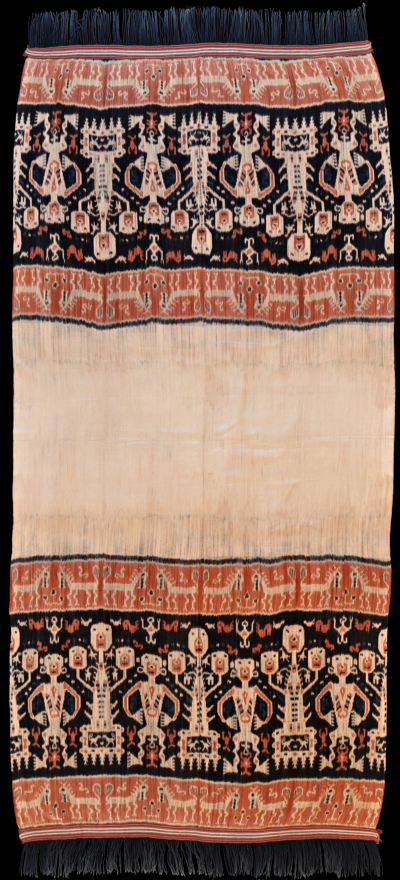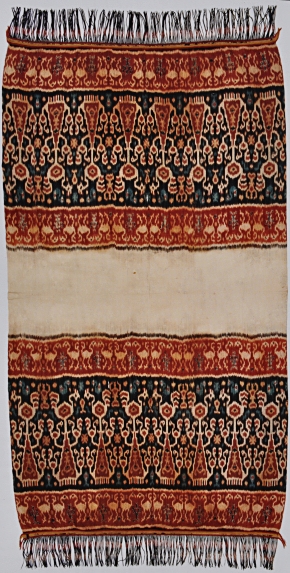| |
 
 | | | |
171 Sumba, East Sumba
Hinggi (men's blanket)  
| | Locale: | Praliu, but in Kanatang style, made by princess from Kanatang. | | Period: | 1960 | | Yarn: | Cotton, commercial, medium, double-ply | | Technique: | Warp ikat | | Panels: | 2 | | Size: | 132 x 275 cm (4' 3" x 9' 0") LW: 2.08 | | Weight: | 1240 g (43.7 oz), 342 g/m2 (1.12 oz/ft2) | | Design: | Design from Kanatang with white midfield reserved for royalty. Upright male figures with penis inserts, skull trees with three skulls each on the central pillar, surrounded by figures from the marapu ancestor cult. As Steven Alpert pointed out, the small pendulent objects in the skull tree are very brash as they represent the weaver's clamoring tor fresh 'fruits', i.e. skulls to be harvested. A cockfight, depicted in a panel in the skull tree (a deviation from tradition) enlivens the scene. Two bands in a strong red with finely drawn horses, snakes and small skull trees. No foreign influence of any kind. All natural dyes. Traditional kakabil, twisted fringes. | | Comment: | Important royal cloth, called hinggi paratu or also hinggi maramba, from 1960, that represents the last period in which such cloths were still made in royal families, and is in that sense historic beyond its age. Very large and heavy, it was made by princess Tamu Rambu Mirinai Danga from Kanatang, wife of the raja of Praliu in the Kambera region. She was married to the raja, who was ill and had no heirs, to prevent dispersion of the heritage. The raja died a few days after she joined him in his kampung in Praliu, on the outskirts of Waingapu. Information on provenance provided by Georges Breguet. Note the very high weight. | | Background: | Chapters on Sumba and East Sumba. | | Exhibited: | Museu do Oriente, Lisbon, 2014/15 | | Published: |
Woven Languages, 2014.
Ikat Textiles of the Indonesian Archipelago, 2018.
Noble Virtuosity: Hidden Asymmetry in Ikat from Sumba, 2024. | | Compare: | 027 015 160 | | Sources: | A similar piece in Metropolitan Museum, Nr. 30.97.10, is depicted in Monni Adams, Classic and eccentric elements in East Sumba textiles; another in Van Hout, Indonesian Textiles at the Tropenmuseum, Fig. 219., TM-1772-1095 (see image below), which has a related motif: a tree-like structure crowned with cocks on all branch tips, and flamingos instead of horses. Another similar hinggi, pre-1937, is in the Rotterdam Volkenkunde collection, RV-2319-27. A similar, undated, example is in the Fine Arts Museum of San Francisco, Nr. 53.42.131. A hinggi that comes close is a royal Kapunduk depicted in Khan Majlis, Woven Messages, Fig. 208, which is likewise composed of seven transverse sections. The total amount of white field is also similar, but the lay-out is reversed: it has an ikated centre field with patola ratu motif, and two white panels bordered, as in our piece, with animal figures in white on morinda red. Also similar is that the white fields are separated from the ikated bands by a dark stripe. A late 19th to early 20th C hinggi in Adams, Forshee, c.s., Decorative Arts of Sumba, p. 98-99, has a somewhat smaller white centre field and a fish motif rather than skull trees.
 | | |

©Peter ten Hoopen, 2025
All rights reserved.
|
|


